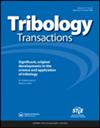The Standard Friction Test Condition between Woven Fabric and Skin in Wet States
IF 2.2
3区 工程技术
Q2 ENGINEERING, MECHANICAL
引用次数: 8
Abstract
In order to recommend a suitable friction test condition in a wet state, the friction force and its fluctuation trend between woven fabric and human skin during the fabric hanging process were investigated. It was found that the friction between fabric and skin first increased and then reached a maximum value in the second time node. Then the friction began to decrease gradually to a minimum value in a dry state. It was noted that the large drops of water on the fabric surface had already scattered and the operability was relatively strong at the second time node. Thus, this suitable relative hanging time (T = 0.2) was recommended as the standard friction test condition between woven fabric and skin in a wet state. It was also found that friction in the recommended wet state was three times that in the dry state. The friction between woven fabric made of natural fibers and skin was generally greater than that for woven fabric made of chemical fibers. Under the recommended friction test conditions, at least nine friction tests were required for each friction pair of woven fabric and human skin.织物与皮肤湿态摩擦试验标准条件
为了推荐合适的湿态摩擦试验条件,研究了织物悬挂过程中织物与人体皮肤之间的摩擦力及其波动趋势。结果表明,织物与皮肤之间的摩擦先增大,在第二个时间节点达到最大值。然后摩擦开始逐渐减小,在干燥状态下达到最小值。在第二个时间节点,织物表面的大水滴已经分散,可操作性较强。因此,推荐该适宜的相对悬挂时间(T = 0.2)作为织物与皮肤湿态摩擦试验的标准条件。还发现,在推荐的湿状态下,摩擦是干状态下的三倍。天然纤维织物与皮肤的摩擦一般大于化学纤维织物与皮肤的摩擦。在推荐的摩擦试验条件下,每对机织织物与人体皮肤的摩擦至少需要进行9次摩擦试验。
本文章由计算机程序翻译,如有差异,请以英文原文为准。
求助全文
约1分钟内获得全文
求助全文
来源期刊

Tribology Transactions
工程技术-工程:机械
CiteScore
3.90
自引率
4.80%
发文量
82
审稿时长
4 months
期刊介绍:
Tribology Transactions contains experimental and theoretical papers on friction, wear, lubricants, lubrication, materials, machines and moving components, from the macro- to the nano-scale.
The papers will be of interest to academic, industrial and government researchers and technologists working in many fields, including:
Aerospace, Agriculture & Forest, Appliances, Automotive, Bearings, Biomedical Devices, Condition Monitoring, Engines, Gears, Industrial Engineering, Lubricants, Lubricant Additives, Magnetic Data Storage, Manufacturing, Marine, Materials, MEMs and NEMs, Mining, Power Generation, Metalworking Fluids, Seals, Surface Engineering and Testing and Analysis.
All submitted manuscripts are subject to initial appraisal by the Editor-in-Chief and, if found suitable for further consideration, are submitted for peer review by independent, anonymous expert referees. All peer review in single blind and submission is online via ScholarOne Manuscripts.
 求助内容:
求助内容: 应助结果提醒方式:
应助结果提醒方式:


